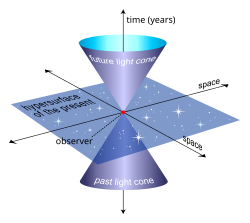World line

A world line is the unique path that an object has as it travels through both space and time, usually called spacetime. As we learn from special relativity, the faster an object goes, the more time slows down for that object. As you can see in the illustration to the right, the slower object has a quicker passage of time than the very fast object, the one which time passes much more slowly for. When an object reaches the speed of light, it will be zero on the t axis, meaning that it will have made no progress in the time direction. Basically, the world lines show that when the speed of light is reached, time stops for the observer. World lines are very often used in theoretical physics and special relativity, as well as general relativity.
Usage
The concept of world lines is used widely in theoretical physics, for it shows some interesting facts about high-speed motion. For example, the time dilation equation presented by Albert Einstein is algebraically undefined when an object's velocity is the speed of light, but using world lines one can find that when the speed is the speed of light, time will stop. Although Einstein's equation (for time dilation) does show that an object going faster than light goes backward in time, the same concept can be described using world lines.
World Line Media
An example of a light cone, the three-dimensional surface of all possible light rays arriving at and departing from a point in spacetime. Here, it is depicted with one spatial dimension suppressed.
The momentarily co-moving inertial frames along the trajectory ("world line") of a rapidly accelerating observer (center). The vertical direction indicates time, while the horizontal indicates distance, the dashed line is the spacetime of the observer. The small dots are specific events in spacetime. Note how the momentarily co-moving inertial frame changes when the observer accelerates.
| Part of a series of articles about |
| General relativity |
|---|
 |
|
Fundamental concepts
|
|
Phenomena
|
|


